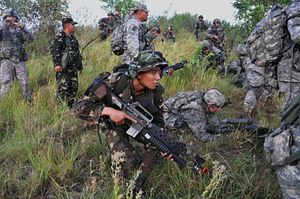As I wrote last week, the United States and the Philippines will be holding the first iteration of their biggest annual bilateral military exercise under Philippine President Rodrigo Duterte known as Balikatan (meaning “shoulder to shoulder” in the national language Tagalog) next month.
Given the anti-American rhetoric we have seen from Duterte since he took office, there has been a lot of buzz about how that might affect actual military-to-military interactions within the decades-old U.S.-Philippine military alliance such as these, even though, as I’ve pointed out repeatedly, there has in fact been much more continuity than change (“What Will the Biggest US-Philippines Military Exercise Look Like Under Duterte?”).
Preparations for some aspects of the exercise have already begun, with community infrastructure projects kicking off and some U.S. personnel arriving in multiple locations in the country. But on April 24, the U.S. embassy in Manila disclosed some additional details about what the 33rd iteration of Exercise Balikatan would look like. The drills, the embassy said in a press release, will proceed from May 8 to 19 at multiple locations in Luzon and the Visayas region and will involve different components, including humanitarian civil assistance projects and training. This is in keeping with the general length as well as the overall nature of the exercise.
However, as Philippine officials have been consistently signaling since late last year, this year Balikatan will also be refocused on fields like humanitarian assistance and disaster relief (HADR) and counterterrorism, while the usually more visible live-fire components will be downplayed (See: “How Much Can Duterte Wreck the US-Philippine Military Alliance?”). Training will be focused on HADR to improve response effectiveness in the event of natural disasters and other crises as well as operational and counterterrorism drills in areas like live fire advanced marksmanship, counter improvised explosive devices (IEDs), maritime interdiction, and amphibious raids.
“Balikatan is designed to meet current challenges facing the Philippines,” Molly Koscina, the U.S. Embassy Press Attaché, said. “Along with preparing the U.S. forces’ and AFP’s ability to respond to natural disasters and deliver humanitarian aid, Balikatan will also increase our militaries’ counterterrorism capabilities.”
As I noted before, while it is not uncommon for exercises to change their focus in accordance with the shifting priorities of actors involved in them, this year’s Balikatan is admittedly a stark contrast from what we had seen under the past few iterations under Duterte’s predecessor Benigno Aquino III. The general tendency in recent years has been expansion rather than scaling down or downplaying, whether it be in terms of numbers, such as the doubling of the size of the war games in 2015, or specific firsts, be it Ash Carter becoming the first ever U.S. defense secretary to observe the Balikatan in 2016 or the involvement of two M142 High Mobility Artillery Rocket System (HIMARS) units which were being deployed for the first time.
The lower profile of the exercises this year has been linked to Duterte’s attempts to rebalance Philippine foreign policy with relatively less dependence on its traditional ally the United States and more diversification with other players including China and Russia(See: “The Limits of Duterte’s US-China Rebalance”). As true as that is, it is important to recognize that a temporary refocusing or scaling down of the Balikatan exercise at the outset of the Duterte administration is not necessarily that bad of an outcome considering where U.S.-Philippine ties started out. It is also still early days with new leaderships on both sides, and things could change further down the line in Manila’s ties with the major powers as they have often done in the past. One thing to watch closely will be U.S. President Donald Trump’s attendance at the regional summitry in Manila later this year which was confirmed last week, since that provides the opportunity of a summit meeting with Duterte (See: “Why Trump Must Go To ASEAN and APEC in the Philippines and Vietnam”).
Furthermore, certain important components of Balikatan that often go unappreciated have been preserved. Perhaps the most critical one is its ability to serve as a path for the multilateralization of U.S. exercises in the region – much like the trajectory of the Cobra Gold exercises – where other U.S. allies and partners like Japan and Australia could either actually participate in varying degrees or attend as observers, thereby broadening what was originally a bilateral drill (See: “Why the Philippines is Critical to the US Rebalance in Asia“). As the U.S. embassy noted, that will continue this year, with Tokyo and Canberra participating in all major training events, and the Philippine military inviting several nations to observe the drills as well.































